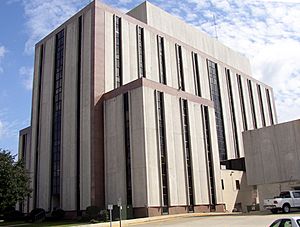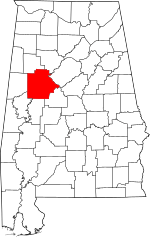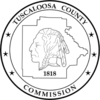Tuscaloosa County, Alabama facts for kids
Quick facts for kids
Tuscaloosa County
|
||
|---|---|---|

Tuscaloosa County Courthouse in Tuscaloosa
|
||
|
||

Location within the U.S. state of Alabama
|
||
 Alabama's location within the U.S. |
||
| Country | ||
| State | ||
| Founded | February 6, 1818 | |
| Named for | Tuskaloosa | |
| Seat | Tuscaloosa | |
| Largest city | Tuscaloosa | |
| Area | ||
| • Total | 1,351 sq mi (3,500 km2) | |
| • Land | 1,322 sq mi (3,420 km2) | |
| • Water | 30 sq mi (80 km2) 2.2% | |
| Population
(2020)
|
||
| • Total | 227,036 | |
| • Estimate
(2023)
|
237,373 |
|
| • Density | 168.05/sq mi (64.885/km2) | |
| Time zone | UTC−6 (Central) | |
| • Summer (DST) | UTC−5 (CDT) | |
| Congressional districts | 4th, 7th | |
|
||
Tuscaloosa County is a county in the central-west part of Alabama. It is a major hub for business, schools, factories, health care, and fun activities in the area.
In 2020, about 227,036 people lived here. This makes it the fifth-most populated county in Alabama. The biggest city and county seat is Tuscaloosa. Tuscaloosa County is part of the larger Tuscaloosa, AL Metropolitan Area. This area also includes Hale and Pickens counties.
The county became famous in 1993. That's when Mercedes-Benz built its first North American car factory here. By 2021, over 4,000 people worked at this plant. Still, The University of Alabama is the county's largest employer. It is also a very important part of the county's economy and culture.
Contents
Discovering Tuscaloosa County's Past
Tuscaloosa County was officially created on February 6, 1818. In the early years, cotton was the main crop grown. Many enslaved African Americans were forced to work on these cotton farms. By 1860, before the Civil War, a large part of the population was enslaved.
After the Civil War, many African Americans moved away. They sought new chances in other counties and bigger cities. This was a time of big changes for everyone.
Later, in the early 1900s, laws were passed in Alabama. These laws made it hard for African Americans to vote. Many also faced unfair treatment. Because of this, many African Americans moved to northern cities. This big move is known as the Great Migration.
By 1960, the number of white residents had grown a lot. The number of Black residents also increased, but at a slower rate. In 1965, the federal Voting Rights Act of 1965 was passed. This law finally gave African Americans the right to vote. Today, people from all backgrounds are involved in the county's government.
In recent times, farming still happens here. Crops like hay, corn, and cotton are grown. Big companies like JVC, Mercedes-Benz, and Uniroyal-Goodrich are also important to the county's economy.
Tornadoes: Powerful Storms in Tuscaloosa
Tuscaloosa County has experienced strong tornadoes. These natural events can cause a lot of damage.
1998 Tornado Event
On April 8, 1998, an F3 tornado hit northeast of Tuscaloosa. It caused injuries and damaged many homes. This tornado traveled about 17 miles. Soon after, an even stronger F5 tornado struck. It hit northeastern Tuscaloosa near the Black Warrior River.
2011 Tornado Outbreak
On April 27, 2011, a very large tornado hit Tuscaloosa. It was part of a huge tornado outbreak in the region. This tornado was about half a mile wide. It caused many deaths and over 1,000 injuries. The damage was massive.
Hospitals in Tuscaloosa treated many injured people. The mayor said that some neighborhoods were "removed from the map." President Obama visited Tuscaloosa after the tornado. He said he had "never seen devastation like this."
Exploring Tuscaloosa County's Geography
Tuscaloosa County covers about 1,351 square miles. Most of this is land, with about 30 square miles of water. It's one of the largest counties in Alabama by land area. The county is in the west-central part of the state. This area is often called West Alabama.
The county sits where two different land regions meet. These are the Appalachian Highlands and the Gulf Coastal Plain. This mix gives the county a varied and interesting landscape.
Neighboring Counties
Tuscaloosa County shares borders with several other counties:
- Walker County (to the northeast)
- Jefferson County (to the east)
- Bibb County (to the southeast)
- Hale County (to the south)
- Greene County (to the southwest)
- Pickens County (to the west)
- Fayette County (to the northwest)
Protected Natural Spaces
Part of the Talladega National Forest is located in Tuscaloosa County. This is a large protected area for nature and wildlife.
People and Population in Tuscaloosa County
The county's population has grown a lot over the years.
| Historical population | |||
|---|---|---|---|
| Census | Pop. | %± | |
| 1820 | 8,229 | — | |
| 1830 | 13,646 | 65.8% | |
| 1840 | 16,583 | 21.5% | |
| 1850 | 18,056 | 8.9% | |
| 1860 | 23,200 | 28.5% | |
| 1870 | 20,081 | −13.4% | |
| 1880 | 24,957 | 24.3% | |
| 1890 | 30,352 | 21.6% | |
| 1900 | 36,147 | 19.1% | |
| 1910 | 47,559 | 31.6% | |
| 1920 | 53,680 | 12.9% | |
| 1930 | 64,153 | 19.5% | |
| 1940 | 76,036 | 18.5% | |
| 1950 | 94,092 | 23.7% | |
| 1960 | 109,047 | 15.9% | |
| 1970 | 116,029 | 6.4% | |
| 1980 | 137,541 | 18.5% | |
| 1990 | 150,522 | 9.4% | |
| 2000 | 164,875 | 9.5% | |
| 2010 | 194,656 | 18.1% | |
| 2020 | 227,036 | 16.6% | |
| 2023 (est.) | 237,373 | 21.9% | |
| U.S. Decennial Census 2010 2020 1790–1960 1900–1990 1990–2000 2010 2020 |
|||
Understanding the 2020 Census Data
The 2020 census showed that Tuscaloosa County is home to a diverse group of people.
| Race / Ethnicity | Pop 2010 | Pop 2020 | % 2010 | % 2020 |
|---|---|---|---|---|
| White alone (NH) | 126,611 | 134,880 | 65.04% | 59.41% |
| Black or African American alone (NH) | 57,401 | 68,779 | 29.49% | 30.29% |
| Native American or Alaska Native alone (NH) | 455 | 420 | 0.23% | 0.18% |
| Asian alone (NH) | 2,293 | 3,241 | 1.18% | 1.43% |
| Pacific Islander alone (NH) | 76 | 94 | 0.04% | 0.04% |
| Some Other Race alone (NH) | 136 | 792 | 0.07% | 0.35% |
| Mixed Race/Multi-Racial (NH) | 1,735 | 6,532 | 0.89% | 2.88% |
| Hispanic or Latino (any race) | 5,949 | 12,298 | 3.06% | 5.42% |
| Total | 194,656 | 227,036 | 100.00% | 100.00% |
Note: The US Census counts Hispanic/Latino people as an ethnic group. This means they can be of any race.
Snapshot of the 2010 Census
In 2010, there were 194,656 people living in Tuscaloosa County. About 76,141 households were counted. The population density was about 147 people per square mile.
The county's population was made up of different racial groups. About 66.3% were White, and 29.6% were Black or African American. About 3.1% of the population identified as Hispanic or Latino.
The average household had 2.42 people. The average family had 3.02 people. About 21.5% of the population was under 18 years old. The median age was 31.2 years.
The median income for a household was $42,311. For families, it was $58,756. About 19.7% of the population lived below the poverty line. This included 22.4% of those under 18.
Life and Fun in Tuscaloosa County
Tuscaloosa County offers a great quality of life. The cost of living here is lower than the national average.
Homes and Housing
The average home value in May 2021 was about $182,303. Between 2020 and 2021, home sales in the county increased by over 31%. This shows a growing housing market.
Outdoor Fun and Recreation
Tuscaloosa County is in the Appalachian foothills. It has 177 miles of shoreline along its rivers and lakes. This is perfect for outdoor activities. The county has 35 parks, covering almost 2,000 acres.
Popular outdoor spots include the 5,000-acre Lake Tuscaloosa. There's also Hurricane Creek and the 250-acre Lake Lurleen in Lake Lurleen State Park.
The University of Alabama Arboretum is a place to see local plants and animals.
Entertainment and Arts
Downtown Tuscaloosa has a lively entertainment area. You can find several music venues there. The Tuscaloosa Amphitheater often hosts live music shows. The historic 1938 Bama Theatre is also a popular event space.
During the summer, the City of Tuscaloosa hosts "Live at the Plaza." This is a free outdoor concert series every Friday evening.
River Market Experience
The Tuscaloosa River Market holds two farmers markets each week. The Saturday market is open all year round. It's a great place to find fresh local goods.
Museums and Art Centers
Tuscaloosa County has many interesting museums. The Alabama Museum of Natural History explores the natural world. The Mildred Westervelt Warner Transportation Museum focuses on how people moved around. The Paul W. Bryant Museum celebrates the history of The University of Alabama's sports teams.
The Children's Hands on Museum (CHOM) is a fun place for kids. It teaches about Tuscaloosa County's history in an interactive way.
The Kentuck Art Center in Northport shows art from about 180 artists. Many of these artists are from Alabama. The center also hosts the annual Kentuck Festival of the Arts. This festival attracts thousands of visitors each year.
College Sports Excitement
College football games are a huge deal in Tuscaloosa. They bring in millions of dollars for the local economy. The University of Alabama has 21 sports teams that compete in the SEC. The Crimson Tide Football team is especially famous.
Alabama teams have won 18 national championships. The Bryant–Denny Stadium is one of the biggest college football stadiums in the world. It can hold over 100,000 fans!
Sports Leagues and Staying Healthy
The Tuscaloosa County Parks and Recreation Authority (PARA) runs seven activity centers. These centers have facilities for basketball, swimming, and workouts. PARA also organizes youth sports leagues. The YMCA offers similar programs.
For tennis players, there are two country clubs and a public facility. The county also has many golf courses, both public and private.
Tuscaloosa County's Economy and Jobs
Tuscaloosa County's economy is strong. It relies on schools, health care, and advanced manufacturing.
Top Employers in the County
The biggest employers in Tuscaloosa County include:
- The University of Alabama
- Mercedes Benz U.S. International
- DCH Regional Medical Center
- Tuscaloosa County Board of Education
- City of Tuscaloosa Board of Education
- Warrior Met Coal, Inc.
- The City of Tuscaloosa
- Michelin/BF Goodrich Tire Manufacturing
- Veterans Administration Medical Center
- SMP Automotive Systems
- Phifer Incorporated
- Brose Tuscaloosa
- Northport Medical Center
- ARD Logistics
- Shelton State Community College
- Bryce Hospital
- Tuscaloosa County
- Nucor Tuscaloosa
- ZF Chassis Systems Tuscaloosa Axel Systems
- Alabama Department of Transportation
Workforce and Training
Tuscaloosa County has a large workforce of about 100,220 people. Many of these are recent graduates from local colleges.
The county works with West AlabamaWorks. This group helps connect government, schools, and businesses. They work together to train people for jobs in a nine-county area. The county also uses statewide resources like Alabama Industrial Development Training (AIDT). AIDT offers free career training programs. The Alabama Technology Network also helps industries with training and technical support.
Both Tuscaloosa City Schools and the Tuscaloosa County School District offer career and technical education. The Tuscaloosa Career & Technology Academy teaches 17 different career paths. The Bill Taylor Institute offers apprenticeship courses for high school students. This is a partnership with Mercedes-Benz and AIDT.
Growing Industries
Tuscaloosa County is looking to grow in new areas. They want to use their research resources and skilled workers. The county has identified six key industries for future growth:
- Research & Development
- Healthcare
- Corporate Operations
- Advanced Manufacturing
- Information Technology
- Energy
Learning in Tuscaloosa County
Tuscaloosa County has excellent schools for all ages.
Colleges and Universities
The county is home to several higher education institutions:
- The University of Alabama: A top research university.
- Shelton State Community College: Offers two-year programs.
- Stillman College: A private liberal arts college founded in 1876. It is a historically black college.
Together, these three schools had 43,681 students in spring 2021.
Schools for Kids and Teens
The Tuscaloosa County School System serves students living outside the city of Tuscaloosa. This system has been operating since 1871. It is managed by a board of 7 elected members. They appoint a superintendent to run the schools daily. In 2020–21, over 18,700 students were enrolled. There are 19 elementary schools, 2 intermediate schools, 7 middle schools, and 6 high schools.
The six county high schools are:
- Brookwood High School (in Brookwood)
- Hillcrest High School (in Taylorville)
- Holt High School (in Holt)
- Northside High School (in Samantha)
- Sipsey Valley High School (in Coker)
- Tuscaloosa County High School (in Northport)
The Tuscaloosa City School System serves students living within the city of Tuscaloosa. About 10,000 students attend these schools. The district has 24 schools. This includes 13 elementary schools, 6 middle schools, and 3 high schools. There are also special campuses for students with unique needs. One campus is for performing arts, and another is for career technical training.
The three city high schools are:
- Paul W. Bryant High School
- Central High School
- Northridge High School
Getting Around Tuscaloosa County
Tuscaloosa County has many ways to travel, from major highways to waterways.
Main Roads

 I-20 / I-59
I-20 / I-59 I-359
I-359 US 11
US 11 US 43
US 43 US 82
US 82 SR 5
SR 5 SR 69
SR 69 SR 171
SR 171 SR 215
SR 215 SR 216
SR 216 SR 297
SR 297 SR 300 (Unsigned route)
SR 300 (Unsigned route)
Toll Roads and Bridges
There is one toll road in the county:
| Road Name | S/W Terminus | N/E Terminus | Length | Cash tolls (automobile) | Notes |
|---|---|---|---|---|---|
| Black Warrior Parkway | 4.9 mi. | $1.50 |
Public Transportation
- Amtrak: The Crescent train stops at the Tuscaloosa station.
- Tuscaloosa Transit Authority: Provides local bus service.
Railways
- Freight trains: Major companies like Kansas City Southern and Norfolk Southern Railway operate here.
- Passenger trains: The county is served by Amtrak's Crescent at the Tuscaloosa station.
Airports and Cargo
- Tuscaloosa National Airport: A local airport.
- Birmingham-Shuttlesworth International Airport: A larger airport nearby.
Waterway Access
The Black Warrior River flows through Tuscaloosa County. This river is part of Alabama's large network of waterways. Alabama has over 1,300 miles of navigable waterways. This is the biggest inland waterway system in the U.S.
The Alabama State Port Authority (ASPA) runs port facilities at the Port of Mobile. This port is about 225 miles from Tuscaloosa. ASPA also operates the Tuscaloosa-Northport Inland Dock in Tuscaloosa County. This dock has a large concrete barge dock and a warehouse.
Parker Towing Company, based in Tuscaloosa, provides barge services. It is one of the largest barge lines in the Southeast.
Communities in Tuscaloosa County
Tuscaloosa County has several cities, towns, and smaller communities.
Cities
- Northport
- Tuscaloosa (the county seat)
Towns
- Brookwood
- Coaling
- Coker
- Lake View
- Moundville (partly in Hale County)
- McCalla (partly in Jefferson County)
- Vance (partly in Bibb County)
- Woodstock (partly in Bibb County)
Census-Designated Places
These are areas that are like towns but not officially incorporated.
Other Communities (Unincorporated)
These are smaller communities without their own local government.
- Abernant
- Buhl
- Caffee Junction
- Duncanville
- Echola
- Elrod
- Fosters
- Kellerman
- Kimbrell (partly in Jefferson County)
- Moores Bridge
- New Lexington
- Peterson
- Ralph
- Romulus
- Samantha
- Sandtown
- Taylorville
- Windham Springs
Historic Ghost Towns
These are places where towns once existed but are now abandoned.
See also
 In Spanish: Condado de Tuscaloosa para niños
In Spanish: Condado de Tuscaloosa para niños


